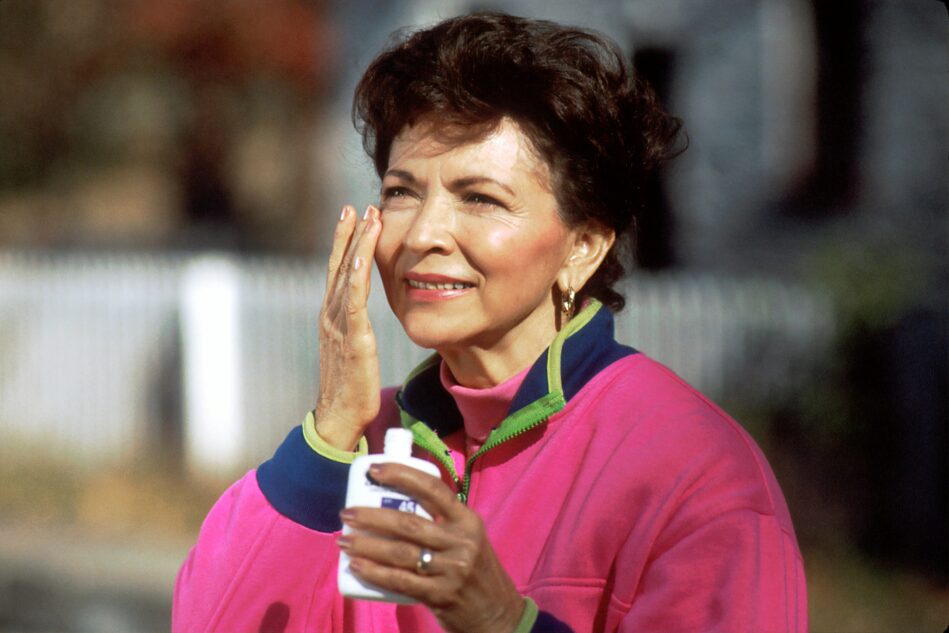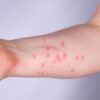“One recent summer day, I saw a fisherman at the clinic and he was burnt to a crisp,” says Hannah Kopelman, MD, a dermatologist at Kopelman Aesthetic Surgery in New York City. Dr. Kopelman says she advised the patient that he had a high risk of developing skin cancer due to his fair skin and occupation, and needed to start wearing safe sunscreen. When she offered him samples to take home, the patient refused. He explained he would rather get a sunburn than wear the protective lotion because he believes sunscreen causes cancer. “He isn’t the only one,” Dr. Kopelman added.
Kopelman has seen several patients in her clinic who refuse to wear sunscreen because they believe it causes cancer–possibly inspired by false information shared on social media. Those rumors are not true, and in fact, the best scientific evidence we have indicates that sunscreen can help prevent certain skin cancers.
That being said, some sunscreens do come with potential risks. In 2019, the U.S. Food and Drug Administration (FDA) requested more studies from manufacturers to better understand the possible risks of certain sunscreens, but the public is still waiting for the results of that research. Meanwhile, here’s what you need to know in order to choose the sunscreen that’s safest and best for you.
Why Wear Sunscreen?
You probably know that sunscreen prevents sunburns. It does this by stopping dangerous ultraviolet rays from penetrating your skin. These rays also damage the DNA in your cells, raising your risk for skin cancer as well as premature signs of aging.1
The best quality evidence suggests that broad spectrum sunscreens—those that protect you from both ultraviolet A (UVA) and ultraviolet B (UVB) rays—can reduce your risk of skin cancer by 40–50%. Studies show that sunscreens block the damaging UVA and UVB rays from harming skin cells in the short term, in animals or petri dishes.2,3,4 Long-term studies that evaluate the effectiveness of wearing it every day are harder to come by. It’s difficult to get a large group of people to wear sunscreen reliably every day (or not) for years and years and wait to see if they develop cancer. However, in 1996, researchers began a study in which participants were randomized to apply sunscreen daily for 4.5 years and were then followed for another 10 years. Participants who had worn sunscreen daily during the 4.5 years were less likely to have been diagnosed with squamous cell carcinoma or melanoma during the follow-up.5,3
Does Sunscreen Cause Cancer?
The short answer is “no.” Sunscreen does not cause any form of cancer. So where did this myth come from? It might have roots in announcements from two sunscreen manufacturers, Johnson & Johnson and Coppertone, who voluntarily recalled some of their aerosol sunscreens from the market because certain samples were found to have been contaminated with benzene, a chemical that can raise your risk of cancers such as leukemia.6,7 Scientists have found benzene in several other cosmetics as well. It’s not an ingredient and it’s not clear how it got there, but the FDA suspects that it could have come from some inactive ingredients made using hydrocarbons.8 “Those lots were removed from the market and since then, we’ve had no problems,” says Dr. Kopelman.
How Does Sunscreen Work?
There are two main types of sunscreen: mineral sunscreen and chemical sunscreen. The active ingredients in each work differently to protect your skin. Mineral sunscreens create a physical barrier that prevents the UV rays from penetrating your skin, while chemical sunscreens induce a chemical reaction to protect your skin.
Mineral Safe Sunscreen
Mineral sunscreen (also called physical sunscreen) uses two different minerals approved by the FDA, zinc oxide and titanium dioxide, to prevent the sun’s rays from penetrating your skin.9 These minerals sit on the skin’s surface and physically block the UVA and UVB rays from damaging it.
Fayne Frey, MD, a dermatologist and the founder of educational website FryFace.com, says, “The zinc oxide protects more of the UVA range than titanium dioxide. So sometimes you’ll see sunscreens that have just zinc oxide. You rarely see ones that have just titanium dioxide.”
A common complaint about these sunscreens is that they can leave white or purple streaks or tints on the skin, especially on darker skin where the white shade pops. These casts appear even more pronounced if the skin gets wet. Kemunto Mokaya, MD, a dermatologist in Houston, recommends using tinted versions of sunscreens to minimize the issue.
Chemical Sunscreen
Chemical sunscreen includes active ingredients such as avobenzone and cinoxate. Dr. Frey explains that these ingredients “absorb the heat and make a chemical reaction, which releases the heat. And that doesn’t allow the ultraviolet light to get into the skin.”
FDA’s Stance on Safe Sunscreen Ingredients
Below is a list of active ingredients that the FDA allows in sunscreens today.
Mineral sunscreen ingredients:
- Titanium Dioxide
- Zinc Oxide
Chemical sunscreen ingredients:
- Avobenzone
- Cinoxate
- Dioxybenzone
- Homosalate
- Meradimate
- Octocrylene
- Octinoxate
- Octisalate
- Oxybenzone
- Padimate O
- Ensulizole
- Sulisobenzone
Possible Risks of Sunscreen
Sunscreens are reviewed by the FDA as over-the-counter (OTC) drugs. The agency designates certain active ingredients as Generally Recognized as Safe and Effective (GRASE) or not GRASE.
In 2019, the FDA announced that the only two substances considered to be GRASE for sunscreens were zinc oxide and titanium dioxide, the minerals found in physical sunscreens. It suggested that two chemicals, aminobenzoic acid (PABA) and trolamine salicylate, were unsafe. For all other chemicals, the agency maintains it needs more information before making a decision, but the products can remain on the market for the time being. We are still waiting for most of that research.
Chemical Sunscreen Absorbed Into Bloodstream
The chemicals in sunscreens can seep into your body through the skin, and it’s not fully known how each chemical might affect your health.10
Researchers have found the following ingredients in the blood and urine of sunscreen wearers:
- Oxybenzone
- Octinoxate
- Homosalate
- Octisalate
- Octocrylene
- Avobenzone
While mineral blockers zinc oxide and titanium dioxide aren’t absorbed through the skin, you can breathe them in if the sunscreen is a spray or powder, so be cautious when using those products.11
Endocrine Disruption
Scientists have found preliminary evidence that at least four of the chemical blockers found in sunscreens could interfere with your hormones, though several of the studies were conducted in petri dishes, animals, and small numbers of humans, so much more research is needed to fully understand the impact these chemicals have on our health.
Oxybenzone, for example, could impact your levels of certain hormones such as thyroid hormone and testosterone.12 One 2019 study suggested that if enough oxybenzone enters through a pregnant woman’s skin, it has the potential to affect the neural development of her fetus.13
Sunscreen ingredients that have been linked to the possibility of hormone disruption include:
- Oxybenzone14
- Octinoxate15
- Homosalate16
- Avobenzone17
Allergic Reactions to Sunscreen
Dr. Frey says if you have sensitive skin, your best bet is to go with a mineral sunscreen. That’s because the chemicals that penetrate your skin in chemical sunscreen are more likely to irritate your skin or exacerbate rosacea, eczema, and acne. Plus, the heat from the chemical reaction itself can also bother skin, explains Beth Goldstein, MD, at Central Dermatology Center in Raleigh, NC. She says, “The chemical blockers can actually flare rosacea.”
Still, some people prefer chemical blockers since they tend to be easier to rub into the skin and less likely to leave white or colored streaking. If you have sensitive skin but still prefer chemical sunscreens, Dr. Frey suggests that you test the product first by putting a little on the back of your ear or arm to make sure you don’t have a reaction before applying it on your face or the rest of your body.
It’s not just the active ingredients in sunscreens that can cause skin irritation and allergies. Since 1994, researchers have found that methylisothiazolinone, a preservative used in some sunscreens and other cosmetics to prevent bacterial and fungal growth, is frequently the culprit behind allergies and skin irritation. When the rash-causing preservative gained attention again in 2014, some companies started removing it from their products.18 However, many products still contain the ingredient.
How to Avoid Unsafe Sunscreens
The Environmental Working Group (EWG) now offers a verification label on sunscreens that it says are free of ingredients of concern. Dr. Kopelman calls the label “generally a good sign” on sunscreens, but adds that “while the EWG certification can be an added assurance of safety and effectiveness, it’s also important to read the full ingredient list and consider other expert recommendations.”
What SPF Does and Doesn’t Tell You
The most ubiquitous identifier of sunscreen’s efficacy, the sun protection factor (SPF) is often misunderstood. The SPF tells you how much UV radiation would be required to burn your skin while wearing that sunscreen.19 For example, it would take more UV radiation to burn you if you’re wearing SPF 60 sunblock than if you’re wearing SPF 15. However, there are two types of UV rays that can damage our skin, UVA rays and UVB rays, and a sunscreen’s SPF primarily gives you information on its ability to block UVB rays.
Dr. Goldstein says, “UVA penetrates deeper into the skin, into the dermis, and suppresses the immune system of the skin and promotes cancer.” That’s why it’s crucial to look not only for a sunscreen’s SPF rating, but also for its “broad-spectrum” label. “Broad-spectrum sunscreen implies that it prevents both UVA and UVB rays from hitting the skin,” adds Goldstein.
Adrienne Haughton, MD, a dermatologist with Stony Brook Medicine in Commack, NY, raises another issue with SPF ratings. The SPF label on the bottle doesn’t always match what’s inside, she says. Independent testing from Consumer Reports has found that nearly half of sunscreens don’t provide even half of the SPF their labels claim.20 For this reason, she suggests wearing a higher SPF sunscreen than you may need.
Are European or Korean Sunscreens Safe as American Sunscreens?
According to the EWG, the difference comes down to regulations.21 The U.S. FDA regulates sunscreen ingredients as OTC pharmaceuticals, while Europe and most of Asia regulate them as cosmetics, which allows new ingredients to come to market after faster review. The FDA hasn’t approved a new UV filtering ingredient since 1996, while other countries have several newer ingredients. Most sunscreens are effective at blocking the UVB rays responsible for causing sunburns, but on average, European and Korean sunscreens tend to be better at blocking the UVA rays that cause subtler damage and can also raise your risk for skin cancer.22
“Asia and Europe are far ahead of us in terms of having more advanced filters for filtering different types of UVA rays,” says Dr. Kopelman.
Additionally, the EU limits the active ingredients allowed in sunscreens that are still used in the US and tied to endocrine disruption and other safety concerns.23
How to Use Safe Sunscreen
“The best sunscreen is the one you use liberally, often, and really put it on. Most people in everyday conditions don’t use enough sunscreen,” says Dr. Frey.
When applying sunscreen, it takes more than you think to get optimal protection. You need a shot glass full for your body and a teaspoon for your face to get the full protective effect promised by your SPF rating. TikToker Maren Taylor Reed shows how much she uses to cover her face, arms, and hands.
Even better than slathering on sunscreen is to avoid the sun at peak hours. “The safest thing is just to seek shade, wear a hat, and stay covered,” says Dr. Haughton. If you choose to go this route, opt for UV-protective clothing and wide-brimmed hats.
Remember, while wearing sunscreen limits the damage the sun can do to your skin, it doesn’t eliminate it. “If you’re laying out in the sun with sunscreen on,” adds Dr. Goldstein, “there’s only so much that sunscreen is going to do for you.”






